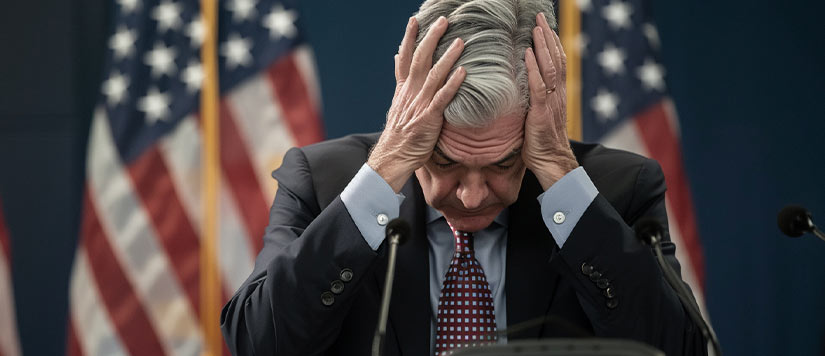
Here’s Why the Inflation Situation is Out of the Fed’s Hands
 Bullion.Directory precious metals analysis 03 May, 2024
Bullion.Directory precious metals analysis 03 May, 2024
By Peter Reagan
Financial Market Strategist at Birch Gold Group
Just before their latest meeting, CNBC reported that not much would change, and summarized the “feeling in the room” regarding Fed rates:
“Pretty much everybody on the FOMC is talking from the same script right now,” said Guy LeBas, chief fixed income strategist at Janney Montgomery Scott. “With maybe one or two exceptions, policymakers pretty universally agree that the last few months of inflation data are too warm to justify action in the near term. But they’re still hopeful that they will be in a position to cut rates later.”
As you’ll read shortly, that summary was fairly accurate. However, being “hopeful” about the possibility of cutting rates “later” raises some doubts.
Going forward, the Federal Reserve has three basic options with rates: raise them, cut them, or leave them alone.
Let’s take a deeper look at the potential consequences of each option, with special focus on the latest FOMC update…
Option #1: Leave rates alone
Thanks mostly to the “Bidenflation” that doesn’t seem like it will ever ease, the Fed opted to leave rates right where they are. At least for now.
Wolf Richter summarized how the latest FOMC update pretty much crushed the hopes of the more optimistic pundits who thought there was any chance the central banks would cut rates in the near-future:
The FOMC statement released today after its two-day meeting acknowledged for the first time that inflation resurfaced as an issue after a series of worrisome inflation reports so far this year have already killed Rate-Cut Mania. It added new language to that effect: “In recent months, there has been a lack of further progress toward the Committee’s 2 percent inflation objective.”
Here’s the relevant part of the official FOMC statement, which confirmed that rates are staying in the range they’ve been for six straight meetings:
Recent indicators suggest that economic activity has continued to expand at a solid pace. Job gains have remained strong, and the unemployment rate has remained low. Inflation has eased over the past year but remains elevated. In recent months, there has been a lack of further progress toward the Committee’s 2 percent inflation objective…
In support of its goals, the Committee decided to maintain the target range for the federal funds rate at 5-1/4 to 5-1/2 percent. In considering any adjustments to the target range for the federal funds rate, the Committee will carefully assess incoming data, the evolving outlook, and the balance of risks. The Committee does not expect it will be appropriate to reduce the target range until it has gained greater confidence that inflation is moving sustainably toward 2 percent.
But holding rates where they are has already allowed the officially reported rate of inflation (CPI) to remain more than 30% above the target rate for the last six FOMC meetings. It’s been locked in a range between 3% and 9.1% every month since April 2021.
So Powell’s strategy doesn’t appear to be working to cool down the inflation rate anymore.
This could also be a signal that if the Fed leaves rates between 5.25-5.50% for the future, the inflation rate might just “hover” or potentially even start heating up again.
If that happens, it would make American life pretty expensive for quite a while, which is a scenario that no one wants.
But if the Fed ever opts for the next option, that could make everything even worse…
Option #2: Raise rates
If leaving rates alone doesn’t solve the inflation problem, then it’s possible the Federal Reserve members could actually start raising rates again.
In fact, Wolf Richter identified a shift in Chairman Powell’s tone that could mean this option is back on the table:
Powell was obviously unenthusiastic about rate hikes, and thought it “unlikely that the next policy rate move will be a hike” – “our policy focus is really how long to keep policy restrictive,” he said. But rate hikes weren’t even on the table before, so that alone was a big shift, from a bunch of rate cuts to having to deal with the possibility of a rate hike.
This means that the Fed could theoretically begin to raise rates again to tame persistent inflation at any point in the future (even the near-future).
The problem with that line of thinking is Republic First bank just closed. Pursuing even higher rates could collapse the banking system (again, just like last year).
But even in the face of potential bank closures, it is possible that a “confused Fed” would do just that. According to Wolf, the words “hike” or “rate hike” were mentioned 8 times during Chairman Powell’s latest press conference.
There was also one other detail Powell mentioned that could push the Fed to “hold” rates high, or even potentially start raising rates again:
My expectation is that we will, over the course of this year, see inflation move back down. That’s my forecast. But my confidence in that is lower than it was because of the data we’ve seen.
On top of that, higher interest rates also have an unintended side effect, especially if left too high for too long. Former Treasury Secretary Larry Summers summarized this “side effect” in a recent NPR interview:
“The simple idea is that part of the cost of living is the cost of money,” Summers said. “And the cost of money is still way elevated from where it was.”
The government’s cost-of-living yardstick used to account for those financing expenses. Until 1983, for example, the consumer price index measured housing prices by tracking monthly mortgage payments.
“So when mortgage rates went up, the CPI went up,” Summers said.
This is one reason why we keep bringing up the difference between “official” inflation, and “real” inflation. Right now, “real” inflation is closer to 11% by the exact same calculation that Summers described in the quote above.
Frankly, completely absurd that professional economists have taken this long to figure out that more expensive credit raises the cost of living. That, or perhaps the Fed just doesn’t want to confront that fact.
But what if Powell did the unthinkable and took the third option?
Option #3: Lower rates
If the Federal Reserve were to lower rates at any time in the near future, that would likely surprise every person with a temperature of 98.6 degrees Fahrenheit.
Taking the “dovish” route would send a strong signal that Powell had given up. That’s because the Fed’s four-year fight against persistent inflation would be over.
So while a confused Fed could surprise everybody and start cutting rates, the odds are that won’t happen. At least not yet.
One thing appears to be certain, however. It looks like we’re nearing the “end of the road.” Time appears to be running out for the Fed to get inflation under control.
Where does that leave us?
As you can plainly see, the Fed doesn’t have a really good way out of this mess.
Now that the Federal Reserve has been backed into a corner, it’s the best time for you to ensure that your retirement savings can weather the incoming economic turmoil.
Examine your retirement plan, then consider the benefits of diversifying with physical precious metals. If you’re in search of a safe haven from market volatility, owning real gold and silver could help to bolster your confidence in a secure retirement.
Here is a fact: Since October of last year, the price of gold has jumped 25% (as of May 2nd, 2024), partly because of the reasons we just discussed.
You can get the rest of the story about the advantages of diversifying with precious metals like gold and silver in our free information kit (updated for 2024!).
Peter Reagan

Peter Reagan is a financial market strategist at Birch Gold Group, one of America’s leading precious metals dealers, specializing in providing gold IRAs and retirement-focused precious metals portfolios.
Peter’s in-depth analysis and commentary is published across major investment portals, news channels, popular US conservative websites and most frequently on Birch Gold Group’s own website.
This article was originally published here











 Material provided on the Bullion.Directory website is strictly for informational purposes only. The content is developed from sources believed to be providing accurate information. No information on this website is intended as investment, tax or legal advice and must not be relied upon as such. Please consult legal or tax professionals for specific information regarding your individual situation. Precious metals carry risk and investors requiring advice should always consult a properly qualified advisor. Bullion.Directory, it's staff or affiliates do not accept any liability for loss, damages, or loss of profit resulting from readers investment decisions.
Material provided on the Bullion.Directory website is strictly for informational purposes only. The content is developed from sources believed to be providing accurate information. No information on this website is intended as investment, tax or legal advice and must not be relied upon as such. Please consult legal or tax professionals for specific information regarding your individual situation. Precious metals carry risk and investors requiring advice should always consult a properly qualified advisor. Bullion.Directory, it's staff or affiliates do not accept any liability for loss, damages, or loss of profit resulting from readers investment decisions.

Leave a Reply